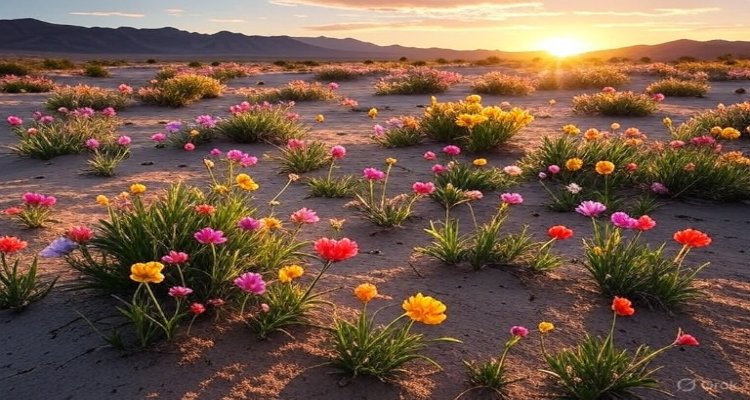The Desert That Blooms Once Every Few Decades
A rare desert phenomenon turns barren landscapes into seas of flowers once every few decades, revealing nature’s resilience and beauty.
Introduction: A Desert Awakens
Imagine walking across a barren wasteland where nothing but sand, rocks, and silence stretch for miles. Then, almost like a secret revealed, the ground erupts in a carpet of wildflowers—vivid purples, yellows, reds, and whites. This breathtaking event happens in some of the world’s driest deserts only once every few decades, transforming desolation into a living masterpiece. Known as desert super blooms, these rare spectacles remind us that even the harshest landscapes hide dormant potential.
Context & Background: Where the Impossible Happens
Deserts cover nearly one-third of the Earth’s land surface, defined by their extreme aridity and unforgiving climate. Many receive less than 10 inches of rainfall a year, making survival a challenge for most plants. Yet, hidden beneath the sand lies an ancient resilience—seeds buried for years, sometimes decades, waiting for just the right conditions.
One of the most famous examples is Chile’s Atacama Desert, often called the driest place on Earth. Rain can be absent for decades, but when El Niño shifts global weather patterns, bringing unusually heavy rainfall, the Atacama awakens in a riot of colors. Similarly, parts of the American Southwest, particularly Death Valley in California, witness super blooms roughly once in a generation, when rare winter rains soak the desert floor.
Main Developments: The Science of Super Blooms
The science behind these desert miracles lies in a mix of timing, rainfall, and temperature. Seeds from hardy desert wildflowers—such as evening primrose, desert lilies, and verbena—can remain dormant under layers of soil for years. When enough rain falls, and the temperatures remain mild, the seeds germinate, sprouting rapidly to take advantage of the fleeting moisture.
However, these blooms aren’t guaranteed. Even in wet years, a sudden rise in heat or strong desert winds can halt the process, killing seedlings before they blossom. This rarity is what makes the phenomenon so treasured: when it does happen, entire valleys transform into a kaleidoscope visible even from space.
Expert Insight & Public Reaction
Botanists often describe these events as “ecological time capsules.” Dr. María del Carmen Ramírez, a Chilean ecologist, explains, “The Atacama bloom is more than beauty—it’s survival. Each flower represents a lineage that has learned to wait out centuries of drought.”
Tourists, scientists, and photographers flock to these regions during super bloom years, often doubling or tripling visitor numbers. Social media further amplifies the phenomenon, turning once-remote landscapes into viral destinations. Yet, experts warn that too much foot traffic can damage fragile ecosystems, crushing flowers and compacting soil where seeds rest for the next bloom cycle.
Impact & Implications: Beyond Beauty
Super blooms are not just visual wonders—they carry ecological significance. They provide food for insects, birds, and small mammals, supporting biodiversity in otherwise barren habitats. For locals, these events can boost eco-tourism, providing rare economic opportunities in desert towns.
But climate change casts a shadow. While increased rainfall in some years might trigger blooms, rising global temperatures threaten seed viability and shorten blooming periods. Scientists stress that protecting these delicate cycles is essential to preserving not just the spectacle but also the life web it sustains.
Conclusion: Waiting for the Next Miracle
The desert that blooms once every few decades is more than a natural curiosity—it’s a reminder of patience, resilience, and hidden potential. These rare super blooms show us that beauty can thrive in the most unlikely places, given time and the right conditions.
As the climate continues to shift, the future of these blooms remains uncertain. But for those lucky enough to witness one, the sight of a desert in full color lingers like a memory etched into the earth itself—a fleeting miracle that reminds us why nature is worth protecting.
Disclaimer:This article is for informational and educational purposes only. Environmental conditions and bloom frequency may vary across regions. Always check local conservation guidelines before visiting fragile ecosystems.











